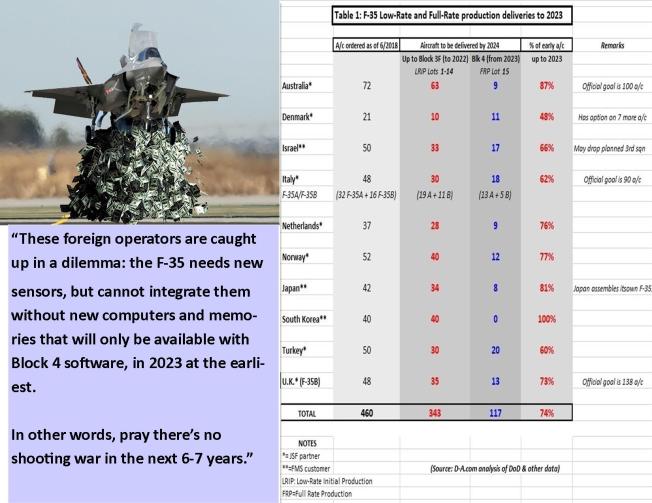 |
| Click on Image or Download to Enlarge |
“DEFENSE-AEROSPACE.COM”
“Three-quarters of all the F-35 Joint Strike Fighters delivered to foreign customers until 2023 are [or will be] obsolete and will require major retrofits before they can deliver their promised performance.
[10] Foreign “partners,” [See table] who have already paid a portion of the F-35’s development costs as well as paying for their own aircraft, will realize that they have been abused by Lockheed and the Pentagon.”
___________________________________________________________________________________________
“An analysis of F-35 contracts awarded to date shows that fully 343 – or 74% — of the 460 export F-35s that Lockheed is to deliver until end 2024 will be in the current, obsolete Low-Rate Initial Production configuration.
These 343 aircraft are limited both in terms of operational capabilities and of the weapons they can use. They are, and will remain, obsolete because their software is incomplete and because their sensors – designed over 20 years ago – have been overtaken by several generations electronics progress.
Lockheed and the F-35 Joint Program Office have quietly decided that all of the planned sensor and avionics upgrades needed to bring the F-35 to full capability will be deferred until 2023, when the first Full-Rate Production (FRP) aircraft (Lot 15) will begin to roll off the production lines.
All this, however, is a best-case scenario, and assumes that the F-35 will pass its Initial Operational Test & Evaluation (IOT&E). Due to be completed in 2019 or 2020, IOT&E will allow the Pentagon to take the (Milestone C) decision to launch Full-Rate Production (FRP).
If it doesn’t – and the
GAO reported on June 5 that “As of January 2018, the F-35 program had 966 open deficiencies, of which 111 category 1 (critical)” – then all bets are off, and the program will have to undergo a major restructuring.
Fully-capable F-35 only after 2023
Aircraft of the first Full-Rate Production batch (Lot 15) will be the first to benefit from the new package of sensors, electronics and software bringing them to full capability, and which will notably include:
— a new TR-3 (Technology Refresh 3) computer supplied by Harris Corporation that is key to allowing integration of the new capabilities planned for the Block 4 standard. This will include computing infrastructure for new panoramic cockpit displays, advanced memory systems and navigation technology, according to Brad Truesdell, Harris Corp.’s senior director of aviation systems.
— Raytheon’s new Electro-Optical Distributed Aperture System, which Lockheed
announced June 13 would replace Northrop Grumman’s current AN/AAQ-37.
— a new
Advanced Electro-Optical Targeting System (EOTS) to replace the current system, also made by Lockheed. The company says the current EOTS meets all the contractual specifications, but that the new system – which offers a significant increase in terms of target recognition and detection capability – “would be a further upgrade option purchased at the discretion of the DOD and international F-35 partners and customers,” Lockheed told FlightGlobal at the time.
— a new Panoramic Cockpit Display System (PCDS) made by Elbit Systems of America. In June 2017,
Elbit announced a contract from Lockheed Martin to develop a panoramic cockpit display unit to replace the current one, made by L3 Aviation Products.
These new sensors are crucial for the F-35 to achieve the capabilities it was designed to deliver, but which are still not available today, after 17 years of development. Lockheed says, for example, that the new DAS will have five times the reliability and twice the performance of the current system, despite being 45% cheaper to buy and 50% cheaper to operate.
However, Lot 15 deliveries will only begin in early 2023 and, meanwhile, deliveries will continue with the current electronics and sensors.
The US services will also receive obsolete aircraft, but their problem is less severe because they all operate other kinds of combat aircraft, and because they already have indicated they may use the early aircraft for flight-training or as spare parts banks if the cost of upgrading them to Block 4 standard is too expensive.
This is not an option for export customers, however, as for several – notably Denmark, Norway, the Netherlands — the F-35 will be the only combat aircraft, while for all others it is the primary strike aircraft.
Allies to receive obsolete aircraft until 2022
Until 2023, all the Low-Rate Initial Production (LRIP) aircraft ordered by the program’s foreign partners (Australia, Denmark, Italy, Netherlands, Norway, Turkey and the United Kingdom) and Foreign Military Sales customers (Israel, Japan and South Korea) will be delivered in the current configuration.
 |
| Click on Image or Download to Enlarge |
They will require substantial — and expensive — upgrades to bring them up to the latest Block 4 standard, after the new sensors and electronics become available in 2023.
The cost of developing and implementing the Block 4 configuration is as yet unknown, and figures have been quoted of between $3.9 billion and
as much as $16.4 billion.
In any case, it is high enough that the F-35 Program Executive Officer, Vice Admiral Mat Winter, “said his office is exploring the option of leaving 108 aircraft in their current state because the funds to upgrade them to the fully combat-capable configuration would threaten the Air Force’s plans to ramp up production in the coming years,” according to an
October 2017 report by the Project On Government Oversight (POGO)
To our knowledge, European operators of the F-35 also have “overlooked” mentioning the cost of upgrading their older aircraft to Block 4 standard when reporting to their respective Parliaments, to which they will now have to go cap-in-hand to request the necessary funds. One can imagine the welcome they will receive from their lawmakers.
And Block 4 is non-negotiable because unless upgraded, all F-35s delivered before 2023 will be severely limited in their capabilities and will only be able to use very few weapons.
Lockheed is currently delivering aircraft with the latest Block 3F software, the first “combat-capable” standard. Block 3F should (but maybe will not) be retrofitted to earlier aircraft. Block 3F allows the use of the Small Diameter Bomb, Joint Direct Attack Munition (JDAM) and the AIM-9X short-range air-to-air missile, in addition to the Advanced Medium Range Air-to-Air Missile (AMRAAM), Advanced Short-Range Air-to-Air Missile (ASRAAM) and various kinds of laser-guided bombs used with earlier software.
Only Block 4 allows most capable weapons – after 2023
But only Block 4 will allow the F-35 to use the most capable air-to-air missile in the Western inventory – MBDA’s Meteor – as well as two new long-range missiles being developed specifically for the F-35: the
Joint Strike Missile (made by Kongsberg, Norway) and the SOM-J air-launched cruise missile (Roketsan, Turkey) as well as the Small Diameter Bomb II and other cutting-edge weapons to come.
If 74% of all export F-35s will be obsolete when delivered, some export customers will receive an even higher proportion: Australia will receive 63 of its 72 aircraft (87%) in LRIP configuration, while the proportion of LRIP aircraft will attain 100% for South Korea, 81% for Japan and 77% for Norway. (see Table 1 above).
Foreign operators will receive a few of the state-of-the-art Lot 15/Block 4 aircraft after 2023, except for South Korea, whose deliveries will be completed in 2021. Quantities will be limited, however, as for example Norway will receive only 12 Block 4 aircraft out of 52, and Australia only 9 out of 72.
These foreign operators are caught up in a dilemma: the F-35 needs new sensors, but cannot integrate them without new computers and memories that will only be available with Block 4 software, in 2023 at the earliest.
In other words, pray there’s no shooting war in the next 6-7 years.
Assuming they do decide to retrofit Block 4 improvements, export customers will have to pay for it themselves, on top of acquisition and post-delivery upgrade costs.
This is when foreign “partners,” who have already paid a portion of the F-35’s development costs as well as paying for their own aircraft, will realize that they have been abused by Lockheed and the Pentagon who, in their rush to produce as many F-35s as fast as possible, have delivered “fifth-generation” aircraft that do not meet contractual performance and cannot match the capability of “legacy” aircraft like Typhoon, and the latest F-15 and F-16s.”




